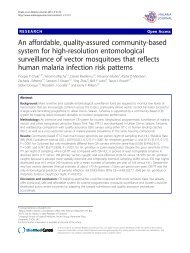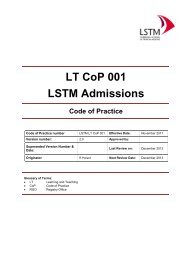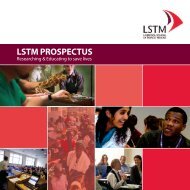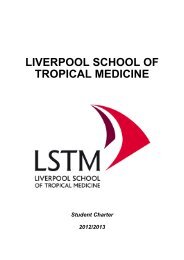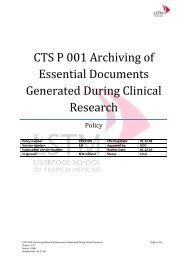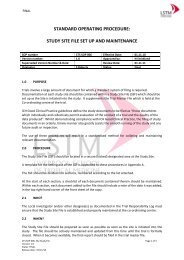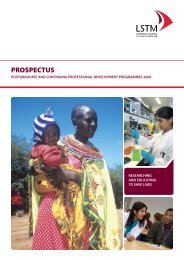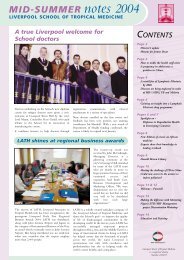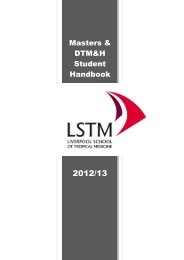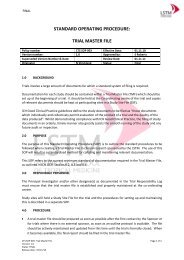Annual Report 2008 - 2009 - Liverpool School of Tropical Medicine
Annual Report 2008 - 2009 - Liverpool School of Tropical Medicine
Annual Report 2008 - 2009 - Liverpool School of Tropical Medicine
Create successful ePaper yourself
Turn your PDF publications into a flip-book with our unique Google optimized e-Paper software.
TROPICAL DRUG DISCOVERY GROUP<br />
PROF S WARD, DR A SHONE,<br />
DR P STOCKS, DR G LAING,<br />
DR S MAUNGNOLCHAROEN AND<br />
DR G DONEGAN<br />
Pr<strong>of</strong>essor Ward’s unit continues to focus on<br />
both basic and applied aspects <strong>of</strong> antinfective<br />
chemotherapy with an emphasis on malaria,<br />
TB and more recently, in collaboration with<br />
Pr<strong>of</strong>essor Taylor, filariasis. Product oriented<br />
research projects are investigating new<br />
antimalarial peroxides, quinolines and<br />
mitochondrial targeted drugs with renewed<br />
funding from the Antimal EU drug discovery<br />
initiative, the Wellcome Trust and the<br />
Biomedical Research Centre <strong>Liverpool</strong>. There<br />
is only a rudimentary understanding <strong>of</strong> how<br />
antimalarial drugs work, compounded by<br />
a lack <strong>of</strong> knowledge <strong>of</strong> parasite physiology.<br />
Understanding the basic physiology and<br />
pharmacology <strong>of</strong> the malaria parasite therefore<br />
underpins much <strong>of</strong> our work. We are currently<br />
involved in characterising parasite transporters,<br />
second messenger signaling and aspects <strong>of</strong><br />
energy metabolism. This has led to significant<br />
advances in our understanding <strong>of</strong> the mode<br />
<strong>of</strong> action <strong>of</strong> antiparasitics and is helping us<br />
to understand the toxicological limitations <strong>of</strong><br />
drugs such as the endoperoxides.<br />
In the past twelve months we have made<br />
significant advances in a number <strong>of</strong> other<br />
areas including the identification <strong>of</strong> potential<br />
resistance breaking pyrethroid insecticides,<br />
the identification <strong>of</strong> biomarkers <strong>of</strong> severe<br />
malaria and TB and the pharmacokinetics <strong>of</strong><br />
antimalarials in pregnancy. In collaboration<br />
with Pr<strong>of</strong>essor O’Neill (<strong>Liverpool</strong> University)<br />
we have used the knowledge gained from our<br />
basic science research to form a platform for<br />
the rational design <strong>of</strong> new drugs, insecticides<br />
and eventual diagnostics.<br />
DR P BRAY AND DR E SALCEDO<br />
Parasite transporters have particular biological<br />
significance in the asexual blood stages <strong>of</strong><br />
malaria. Various transport processes must<br />
adapt to the intracellular milieu <strong>of</strong> the host<br />
erythrocyte and the extracellular environment<br />
that is encountered during reinvasion,<br />
potentially making them suitable for<br />
chemotherapeutic targeting.<br />
The group is focused on the molecular<br />
characterisation <strong>of</strong> malaria parasite<br />
transporters, as they can serve as specific<br />
access routes for drug delivery into the<br />
intracellular parasite and be important<br />
mediators <strong>of</strong> drug resistance, as well as drug<br />
targets in their own right.<br />
Current projects encompass folate transport,<br />
organic cation transport, amino acid transport<br />
and drug transport in Plasmodium falciparum.<br />
Some <strong>of</strong> these studies have provided new<br />
insights into the mechanisms <strong>of</strong> folate salvage<br />
in Plasmodium falciparum. The parasite is<br />
able to salvage pre-formed folates and<br />
folate precursors such as para-aminobenzoic<br />
acid (pABA) using two plasma membrane<br />
transporters characterised by our group and<br />
termed PfFT1 and PfFT2.<br />
Other work has examined the drug transport<br />
mechanism and the endogenous role <strong>of</strong><br />
the P. falciparum chloroquine resistance<br />
protein PfCRT. Some <strong>of</strong> this work, conducted<br />
in collaboration with Pr<strong>of</strong>essor Sylke Muller<br />
at Glasgow University, has revealed a<br />
previously unsuspected role in the parasite<br />
glutathione pathway. We have provided the<br />
first demonstration <strong>of</strong> peptide transport by<br />
PfCRT and have focused on the transport <strong>of</strong><br />
the tripeptide glutathione. We have shown<br />
that mutant forms <strong>of</strong> PfCRT are also able<br />
to transport glutathione into the digestive<br />
vacuole. Once inside, glutathione destroys<br />
some <strong>of</strong> the heme target, making a significant<br />
contribution to chloroquine resistance.<br />
Dr G Biagini, Dr N Fisher and<br />
Dr A Warman<br />
Resistence to antimalarials is an increasing<br />
problem, requiring new drugs with novel<br />
targets. Key to this is a better understanding<br />
<strong>of</strong> the malaria parasite biochemistry and<br />
physiology in order to exploit differences for<br />
future chemotherapies and to circumvent<br />
resistance mechanisms.<br />
Current projects have focused on two main<br />
parasitic organelles, the digestive food vacuole<br />
(DV) and the mitochondrion. The DV is the site<br />
<strong>of</strong> haemoglobin digestion and the by-product<br />
<strong>of</strong> this process – heme (or ferriprotoporphyrin<br />
IX) – is the target <strong>of</strong> a number <strong>of</strong> quinolinebased<br />
drugs. The DV is also the site <strong>of</strong> two<br />
key transporters, Pgh1 and PfCRT, responsible<br />
for resistance to quinoline-based drugs. Our<br />
studies have focused on understanding<br />
the physiology <strong>of</strong> the DV such as pH and<br />
Ca2+ homeostasis, in an effort to elucidate<br />
resistance mechanisms. We have discovered<br />
that the acidic DV contains elevated (relative<br />
to cytosol) free Ca2+ which is regulated by<br />
a H+-dependent transporter(s) and have<br />
characterised a transporter found on the<br />
DV membrane that is responsible for Ca2+<br />
transport.<br />
The electron transport chain (ETC) <strong>of</strong> the<br />
parasite mitochondrion is also being analysed<br />
as a possible chemotherapeutic target. Unlike<br />
the human host, the parasite ETC does not<br />
contain Complex I but instead possess a type<br />
II NADH:quinone-oxidoreductase otherwise<br />
known as “alternative complex I”. This enzyme<br />
has recently been genetically and chemically<br />
validated as a potential chemotherapeutic<br />
target. Grants from the Leverhulme Trust and<br />
the Wellcome Trust are funding studies to<br />
deconvolute the structure and function <strong>of</strong> this<br />
enzyme and to develop drug candidates from<br />
medicinal chemistry QSAR (with Pr<strong>of</strong>essor Paul<br />
O’Neill at the University <strong>of</strong> <strong>Liverpool</strong>) and high<br />
throughput screening activities. This essential<br />
enzyme is also found in Mycobacterium<br />
tuberculosis (Mtb), and through funding from<br />
the Biomedical Research Centre we have<br />
embarked on a 5 year programme to develop<br />
anti Mtb inhibitory molecules. In addition we<br />
have recently discovered potent antimalarial<br />
compounds selective against the plasmodium<br />
mitochondrial bc1, and efforts are underway<br />
to secure a drug discovery programme for this<br />
new class <strong>of</strong> antimalarials.<br />
Dr I M Hastings<br />
Dr Hastings works on identifying and<br />
quantifying the forces driving drug resistance<br />
and how drug deployment could minimise<br />
resistance. Recent research has focused on<br />
how best to analyse surveillance data on<br />
mutations known to encode drug resistance<br />
and how to translate these data into policy<br />
recommendations. Collaboration with the<br />
Swiss <strong>Tropical</strong> Institute and renewal <strong>of</strong> BMGF<br />
funding to model malaria epidemiology has<br />
funded a PhD studentship, Katherine Winter, to<br />
start integrating drug pharmacology into the<br />
genetic understanding <strong>of</strong> how drug resistance<br />
arises and spreads. Susana Barbosa has joined<br />
from Portugal and will work on the related<br />
problem <strong>of</strong> how insecticide resistance spreads<br />
through populations <strong>of</strong> mosquitoes.<br />
LSTM ANNUAL REPORT 27



